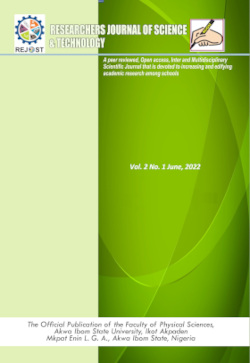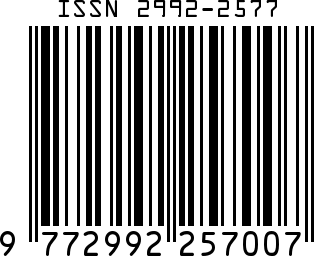Extraction of Iron (II) and Nickel (II) ions from Aqueous Solution using Palm Kernel Oil as a Green Extractant
Keywords:
Solvent extraction, Iron (II) ions, Nickel (II) ions, Percent Extraction Efficiency, Distribution Coefficient, Green ExtractantAbstract
A phase mediated, solvent extraction process was used in the removal of Fe (II) and Ni (II) ions from aqueous solutions. The organic phase was constituted with palm kernel oil (PKO) and the aqueous phase was equally modified with ethylenediaaminetetraacetic acid (EDTA), as a chelating agent. Gas Chromatography Mass Spectrometry (GC-MS) and Flame Atomic Absorption Spectrophotometry (FAAS) were used to analyse the chemical composition of the PKO and the concentration of the metal ions present in the aqueous solutions, after the extraction procedures, respectively. The results from the GC-MS showed that the PKO consisted of fatty acids, mainly tridecanoic acid (32.16 %), pentadecanoic (18.02 %), dodecanoic (16.13 %), and hexadecenoic acid (12.4%). The concentrations of the metal ions after our extraction procedures were used to evaluate the percent extraction efficiency and the distribution ratio. High values of percent extraction efficiency, in the range of 97.37 – 99.21 percent and 97.19 – 99.78 percent, were achieved for the removal of Fe (II) and Ni (II) ions respectively. Equally, the values of the distribution coefficient were in the range of 37.03 – 124.93 as well as 34.57 – 459.79 for the removal of Fe (II) and Ni (II) ions. The percent extraction efficiency and the distribution coefficient increased with increase in initial concentration of these metal ions in the aqueous solution as well as with the volume of PKO that served as the organic phase. This was due to an equilibrium position shift in the direction that favoured the removal of the Fe (II) and Ni (II) ions from the aqueous phase. The presence of EDTA caused a further increase in the case of the extraction of Fe (II) ions but minimal effect was noted in the case of Ni (II) ions. The results obtained revealed that PKO, with or without a chelating agent, can serve as an excellent green extractant for the removal of Fe (II) and Ni (II) metal ions from aqueous solutions.
References
Abd Elnabi, M. K., Elkaliny, N. E., Elyazied, M. M., Azab, S. H., Elkhalifa, S. A., Elmasry, S., Mouhamed, M. S., Shalamesh, E. M., Alhorieny, N. A.,
Abd Elaty, A. E., Elgendy, I. M., Etman, A. E., Saad, K. E., Tsigkou, K., Ali, S. S., Kornaros, M., & Mahmoud, Y. A.-G. (2023). Toxicity of Heavy Metals and Recent Advances in Their Removal: A Review. Toxics, 11(7), 580. https://www.mdpi.com/2305-6304/11/7/580
Abdel Salam, O. E., Reiad, N. A., & ElShafei, M. M. (2011). A study of the removal characteristics of heavy metals from wastewater by low-cost adsorbents. Journal of Advanced Research, 2(4), 297-303. https://doi.org/https://doi.org/10.1016/j.jare.2011.01.008
Agrawal, A., & Sahu, K. K. (2010). Problems, prospects and current trends of copper recycling in India: An overview. Resources, Conservation and Recycling, 54(7), 401-416. https://doi.org/https://-doi.org/10.1016/j.resconrec.2009.09.005
Al-Nuaim, M. A., Alwasiti, A. A., & Shnain, Z. Y. (2023). The photocatalytic process in the treatment of polluted water. Chemical Papers, 77(2), 677-701. https://doi.org/10.1007/s11696-022-02468-7
Al-Qodah, Z. (2006). Biosorption of heavy metal ions from aqueous solutions by activated sludge. Desalination, 196(1-3), 164-176.
Alam, R., Khan, S. U., Usman, M., Asif, M., & Farooqi, I. H. (2022). A critical review on treatment of saline wastewater with emphasis on electrochemical based approaches. Process Safety and Environmental Protection, 158, 625-643. https://doi.org/https://doi.org/10.1016/j.psep.2021.11.054
Amri, I. N. (2011). The Laurice (Coconut and Palm Kernel) oils. In F. D. Gunstone (Ed.), vegetableoils in food technoloy:Composition, properties and uses (pp. 169-197). https://doi.org/10.1002/9781444339925.ch6
Barakat, M. (2011). New Trends in Removing Heavy Metals from Industrial Wastewater. Arabian Journal of Chemistry, 4, 361-377. https://doi.org/10.1016/j.arabjc.2010.07.019
Bhattacharya, A. (2003). Chapter 4-Lipid Metabolism in plants under Temperature. In A. Bhattacharya (Ed.), Effect of high Temperature on Crop Productivity and Metabolism of Macro Molecules (pp. 311-389). Academic Press. https://doi.org/10.1016/B978-0-12-817562-0.00004-5
Bolisetty, S., Peydayesh, M., & Mezzenga, R. (2019). Sustainable technologies for water purification from heavy metals: review and analysis [10.1039/-C8CS00493E]. Chemical Society Reviews, 48(2), 463-487. https://doi.-org/10.1039/C8CS00493E
Cao, X., & Ito, Y. (2003). Supercritical fluid extraction of grape seed oil and subsequent separation of free fatty acids by high-speed counter-current chromatography. Journal of Chromatography A, 1021(1), 117-124. https://doi.org/https://doi.org/10.1016/j.chroma.2003.09.001
Carolin, C. F., Kumar, P. S., Saravanan, A., Joshiba, G. J., & Naushad, M. (2017). Efficient techniques for the removal of toxic heavy metals from aquatic environment: A review. Journal of Environmental Chemical Engineering, 5(3), 2782-2799. https://doi.org/https://doi.org/10.1016/j.jece.2017.05.029
Degenhardt, A., Habben, S., & Winterhalter, P. (2002). Isolation of the lignan secoisolariciresinol diglucoside from flaxseed (Linum usitatissimum L.) by high-speed counter-current chromatography. J Chromatogr A, 943(2), 299 - 302. https://doi.org-/10.1016/s00219673(01)01467-4
Do, J.-M., Jo, S.-W., Kim, I.-S., Na, H., Lee, J. H., Kim, H. S., & Yoon, H.-S. (2019). A Feasibility Study of Wastewater Treatment Using Domestic Microalgae and Analysis of Biomass for Potential Applications. Water, 11(11), 2294. https://www.mdpi.com/20734441/11/11/2294
Edem, D. O. (2002). Palm oil: biochemical, physiological, nutritional, hematological, and toxicological aspects: A review. Plant foods for human nutrition, v. 57(no. 3/4), pp. 319-341-2002 v.2057 no.2003/2004. https://doi.org/10.1023/A:1021828132707
Fu, F., & Wang, Q. (2011). Removal of heavy metal ions from wastewaters: A review. Journal of Environmental Management, 92(3), 407-418. https://doi.org/-https://doi.org/10.1016/j.jenvman.2010.11.011
Geus, H. J. d., Aidos, I., Boer, J. d., Luten, J. B., & Brinkman, U. A. T. (2001). Characterisation of fatty acids in biological oil samples using comprehensive multidimensional gas chromatography. Journal of Chromatography. A, Including electrophoresis and other separation methods, 910, 95-103. https://doi.org/-10.1016/S0021-9673(00)01183-3
Gibon, V. (2012). 12 - Palm Oil and Palm Kernel Oil Refining and Fractionation Technology. In Palm Oil (pp. 329-375). AOCS Press. https://doi.org/https://-doi.org/10.1016/B978-0-9818936-9-3.50015-0
Gurreri, L., Tamburini, A., Cipollina, A., & Micale, G. (2020). Electrodialysis Applications in Wastewater Treatment for Environmental Protection and Resources Recovery: A Systematic Review on Progress and Perspectives. Membranes (Basel), 10(7). https://doi.-org/10.3390/membranes10070146
Ite, I. A., Nyong, A. E., Ite, A. E., Alexander, J. A., & Ibok, U. J. (2023). Phase Transfer-Mediated Removal of Copper (II) and Zinc (II) Ions from Aqueous Solution. Researchers Journal of Science and Technology, 3(2), 15 - 30. https://rejost.com.ng/index.php/home/article/view/55
Izah, S. C., Aigberua, A. O., & Srivastav, A. L. (2022). Chapter 4 - Factors influencing the alteration of microbial and heavy metal characteristics of river systems in the Niger Delta region of Nigeria. In S. Madhav, S. Kanhaiya, A. Srivastav, V. Singh, & P. Singh (Eds.), Ecological Significance of River Ecosystems (pp. 51-78). Elsevier. https://doi.org/https://-doi.org/10.1016/B978-0-323-85045-2.00005-4
Jisha, K. J., Athira, K. K., Priyana, V. P., & Gardas, R. L. (2023). Chapter 10 - Liquid-liquid extraction. In C. Verma & D. K. Verma (Eds.), Handbook of Biomolecules (pp. 227-239). Elsevier. https://doi.org/https://doi.org/10.1016/B978-0-323-91684-4.00026-8
Kalhapure, R. S., & Akamanchi, K. G. (2013). A novel biocompatible bicephalous dianionic surfactant from oleic acid for solid lipid nanoparticles. Colloids Surf B Biointerfaces, 105, 215-222. https://doi.org/10.1016/j.colsurfb.2013.01.011
Khulbe, K. C., & Matsuura, T. (2018). Removal of heavy metals and pollutants by membrane adsorption techniques. Applied Water Science, 8(1), 19. https://doi.org/10.1007/s13201-018-0661-6
Komulainen, T., Doyle Iii, F. J., Rantala, A., & Jämsä-Jounela, S.-L. (2009). Control of an industrial copper solvent extraction process. Journal of Process Control, 19(1), 2-15. https://doi.org/https://doi-.org/10.1016/j.jprocont.2008.04.019
Mobasherpour, I., Salahi, E., & Ebrahimi, M. (2012). Removal of divalent nickel cations from aqueous solution by multi-walled carbon nano tubes: equilibrium and kinetic processes. Research on Chemical Intermediates, 38(9), 2205-2222. https://doi.org/10.1007/s11164-012-0537-6
Nainggolan, M., & Sinaga, A. G. S. (2021). Characteristics of fatty acid composition and minor constituents of red palm olein and palm kernel oil combination. J Adv Pharm Technol Res, 12(1), 22-26. https://doi.org/10.4103/japtr.JAPTR_91_20
Nemerow, N. L., & Agardy, F. J. (1998). Strategies of industrial and hazardous waste management. John Wiley & Sons.
Nyamato, G. S., Wambugu, K., Kiratu, J., & Ojwach, S. O. (2022). Liquid-liquid extraction of copper(II), zinc(II), cadmium(II), and lead(II) from aqueous solution and sewage effluent using phenoxy-amino ligands. Water Science and Technology, 85(10), 2993-3001. https://doi.org/10.2166/wst.2022.164
Obotey Ezugbe, E., & Rathilal, S. (2020). Membrane Technologies in Wastewater Treatment: A Review. Membranes (Basel), 10(5). https://doi.org/10.3390/-membranes10050089
Poku, K. (2002a). Small-scale Palm Oil Processing in Africa. Food and Agriculture Organization of the United Nations. https://books.google.com.ng/books?id=cET5PdWGbIQC
Qasem, N. A. A., Mohammed, R. H., & Lawal, D. U. (2021). Removal of heavy metal ions from wastewater: a comprehensive and critical review. Nature Partner Journals-Clean Water, 4(1), 36. https://doi.org/10.1038/s41545-021-00127-0
Rani, L., Srivastav, A. L., Kaushal, J., Grewal, Ajmer S., & Madhav, S. (2022). Chapter 3 - Heavy metal contamination in the river ecosystem. In S.
Madhav, S. Kanhaiya, A. Srivastav, V. Singh, & P. Singh (Eds.), Ecological Significance of River Ecosystems (pp. 37-50). Elsevier. https://doi.org/https://doi.org/10.1016/B978-0-323-85045-2.00016-9
Sureshkumar, K., Kempegowda, R. G., & Ramakrishnappa, T. (2023). 31 - Electrochemical recovery of metals from industrial wastewaters. In M.
Sillanpää, A. Khadir, & K. Gurung (Eds.), Resource Recovery in Industrial Waste Waters (pp. 639-654). Elsevier. https://doi.org/https://doi.org/10.1016/B978-0-323-95327-6.00035-X
Tchounwou, P. B., Yedjou, C. G., Patlolla, A. K., & Sutton, D. J. (2012). Heavy metal toxicity and the environment. Molecular, Clinical and Environmental Toxicology, 101, 133-164. https://doi-.org/10.1007/978-3-7643-8340-4_6
Volesky, B. (2007). Biosorption and me. Water Research, 41(18), 4017-4029. https://-doi.org/https://doi.org/10.1016/j.watres.2007.05.062
Yang, J., Lee, J. Y., & Ying, J. Y. (2011). Phase transfer and its applications in nanotechnology [10.1039/B916790K]. Chemical Society Reviews, 40(3), 1672-1696. https://doi.org/10.1039/B916790K
Zhao, M., Xu, Y., Zhang, C., Rong, H., & Zeng, G. (2016). New trends in removing heavy metals from wastewater. Applied Microbiology and Biotechnology, 100(15), 6509-6518. https://doi.org/10.1007/s00253-016-7646-x

Downloads
Published
How to Cite
Issue
Section
License
Copyright (c) 2023 Researchers Journal of Science and Technology

This work is licensed under a Creative Commons Attribution-NonCommercial-NoDerivatives 4.0 International License.




